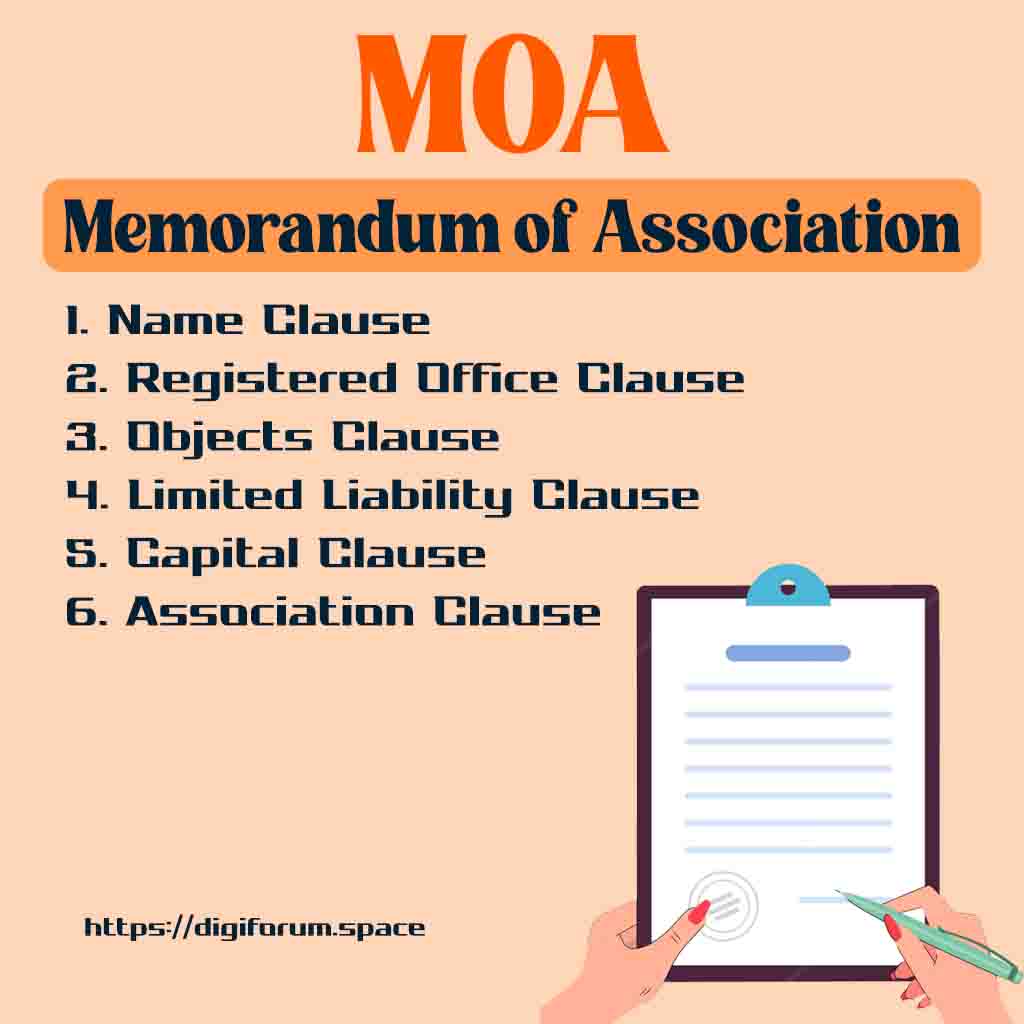What is Memorandum of Association? - Digiforum Space
Share
Facebook X LinkedIn Tumblr Pinterest Pocket Skype Messenger Messenger Viber
Memorandum of Association
When it comes to establishing a company in India, there are several legal documents that need to be prepared and filed. One such crucial document is the Memorandum of Association (MOA). The MOA holds immense importance as it outlines the fundamental aspects of a company’s existence, including its objectives, scope of operations, and the relationship it establishes with shareholders and stakeholders. In this article, we delve into the concept of Memorandum of Association in India, its key components, and its significance for businesses.
What is the Memorandum of Association?
The Memorandum of Association, often referred to as the MOA, is a legal document that serves as the foundation of a company’s constitution. It contains vital information about the company’s objectives, powers, and limitations within which it operates. The MOA acts as a contract between the company and its shareholders, defining their rights and obligations.
Related Articles
- Check company registration number online
- private limited company registration in india
- CIN Number Registration
- Punishment for forex trading in India
- BuyNearby Registration Procedure – Paynearby
Key Components of the Memorandum of Association:
Name Clause: This clause specifies the name of the company, ensuring that it is unique and complies with the rules and regulations set forth by the Registrar of Companies (RoC).
Registered Office Clause: It states the official address of the company’s registered office, which is required for all official communications and legal purposes.
Object Clause: This section outlines the main objectives and activities that the company aims to undertake. It is important to draft this clause precisely, as any activity not mentioned in this clause cannot be pursued by the company.
Liability Clause: The MOA specifies the liability of members in case the company winds up or faces financial distress. It can either be limited by shares, limited by guarantee, or unlimited liability.
Capital Clause: The capital clause outlines the authorized capital of the company, i.e., the maximum amount of capital the company can raise by issuing shares to its shareholders.
Association and Subscription Clause: This clause highlights the number of shares subscribed by the initial shareholders and their agreement to become members of the company.
Do you know?
What is MCA Registration?
MCA stands for the Ministry of Corporate Affairs, which is a government body responsible for regulating and administering corporate affairs in India. MCA registration refers to the process of registering a company or LLP (Limited Liability Partnership) with the Ministry of Corporate Affairs. It involves submitting necessary documents and fulfilling legal requirements to obtain a certificate of registra…… Read more here.
Importance of the Memorandum of Association:
Legal Standing: The MOA gives a company its legal identity. It serves as proof of the company’s existence and is essential for legal proceedings, contracts, and agreements.
Protection of Shareholders’ Interests: The MOA provides a framework for protecting the rights and interests of shareholders. It outlines the relationship between the company and its shareholders, ensuring transparency and accountability.
Boundaries of Operations: The MOA sets the scope and limitations within which the company can conduct its business activities. It prevents the company from engaging in activities that are not aligned with its stated objectives.
Investors’ Confidence: Potential investors and financial institutions often review the MOA to assess the company’s objectives, scope, and potential risks. A well-drafted MOA can instill confidence in investors, aiding in fundraising efforts.
Procedure for Drafting and Altering the Memorandum of Association:
Drafting: The MOA must be prepared in compliance with the provisions of the Companies Act, 2013. It is usually drafted by legal professionals or company secretaries and should adhere to the prescribed format.
Alteration: If any changes need to be made to the MOA, such as altering the company’s name, registered office, or objectives, the company must follow the prescribed procedure, including obtaining the approval of shareholders and the RoC.
Conclusion:
The Memorandum of Association is a critical document that defines the foundation and scope of a company’s operations in India. It ensures clarity, transparency, and legal compliance, safeguarding the interests of shareholders and stakeholders. Entrepreneurs and business owners should understand the significance of the MOA and ensure its careful drafting and compliance throughout the life of their company. By doing so, they can establish a strong legal framework and foster investor confidence in their business endeavors.
FAQs – Frequently Asked Questions
Q1: What is a Memorandum of Association?
A1: The Memorandum of Association (MOA) is a legal document that serves as the foundation of a company’s constitution. It outlines the company’s objectives, powers, and limitations within which it operates. It acts as a contract between the company and its shareholders, defining their rights and obligations.
Q2: Why is the Memorandum of Association important?
A2: The MOA holds immense importance as it provides the legal standing for a company. It serves as proof of the company’s existence and is essential for legal proceedings, contracts, and agreements. Additionally, it protects the interests of shareholders, sets the boundaries for the company’s operations, and instills confidence in potential investors.
Q3: What are the key components of the Memorandum of Association?
A3: The MOA consists of several key components, including: 1. Name Clause: Specifies the company’s unique name. 2. Registered Office Clause: States the official address of the company’s registered office. 3. Object Clause: Outlines the main objectives and activities the company aims to undertake. 4. Liability Clause: Specifies the liability of members in case of financial distress. 5. Capital Clause: Outlines the authorized capital of the company. 6. Association and Subscription Clause: Highlights the number of shares subscribed by initial shareholders.
Q4: Can the Memorandum of Association be altered or amended?
A4: Yes, the MOA can be altered or amended. However, any changes must follow the prescribed legal procedures, including obtaining the approval of shareholders and the Registrar of Companies (RoC). Alterations may include changes to the company’s name, registered office, objectives, or capital.
Q5: Is the Memorandum of Association a public document?
A5: Yes, the MOA is a public document. It can be accessed by the general public for reference and verification purposes. It is filed with the RoC during the incorporation process and is available for public inspection.
Q6: Who prepares the Memorandum of Association?
A6: The MOA is typically prepared by legal professionals, such as lawyers or company secretaries. They have the expertise to draft the document in compliance with the provisions of the Companies Act, ensuring its accuracy and legality.
Q7: Can the Memorandum of Association be used as a standalone document?
A7: The MOA cannot be used as a standalone document. It is accompanied by the Articles of Association (AOA), which contain the rules and regulations governing the internal management of the company. Together, the MOA and AOA form the constitution of the company.
Q8: Can the objectives of a company be changed after the Memorandum of Association is filed?
A8: Yes, the objectives of a company can be changed after the MOA is filed. However, any changes to the objectives require the alteration of the MOA, following the prescribed legal procedures and obtaining the necessary approvals.
Q9: Can a company engage in activities not mentioned in the Memorandum of Association?
A9: No, a company cannot engage in activities that are not mentioned in its MOA. The MOA sets the scope and limitations within which the company can operate. Any activity not mentioned in the MOA would be considered outside the company’s authorized operations.
Q10: Is it possible to form a company without a Memorandum of Association?
A10: No, it is not possible to form a company without a Memorandum of Association. The MOA is a mandatory legal document required during the incorporation process. It establishes the company’s existence, objectives, and relationship with shareholders, making it an essential requirement.
Copy URL URL Copied
Send an email 10/06/20230 258 3 minutes read
Share
Facebook X LinkedIn Tumblr Pinterest Pocket Skype Messenger Messenger ViberShare
Facebook X LinkedIn Tumblr Pinterest Reddit VKontakte Odnoklassniki Pocket Skype Share via Email Print





